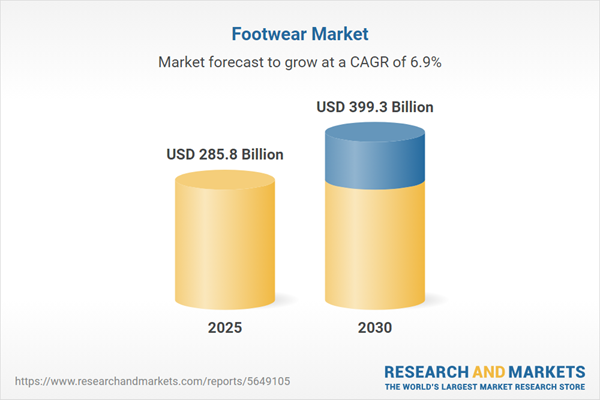The Global Footwear Market is expected to grow at a compound annual growth rate (CAGR) of 6.92% from US$285.804 billion in 2025 to US$399.304 billion in 2030.
The global footwear market is poised for growth, primarily fueled by increasing population and subsequent demand for footwear. Growing awareness of footwear in developing countries, rising purchasing power in emerging economies like Asia-Pacific, and innovations in footwear technology, particularly in customized athletic shoes, are also key drivers.
The global footwear market is poised for growth, primarily fueled by increasing population and subsequent demand for footwear. Growing awareness of footwear in developing countries, rising purchasing power in emerging economies like Asia-Pacific, and innovations in footwear technology, particularly in customized athletic shoes, are also key drivers.
Market Growth Drivers:
- Population Growth, Demographic Shifts, and Rising Disposable Income: The increasing global population is directly increasing the demand for footwear. Furthermore, the shift from rural to urban living is positively impacting footwear demand globally. Rising disposable incomes are also leading consumers to spend more on premium and branded footwear.
- The World Population Prospects 2022 projects India's population to reach 1.51 billion by 2030, up from 1.41 billion in 2022.
- United Nations Population Division data indicates that 57% of the global population lived in urban centers in 2023, compared to 51% in 2010.
- Rising Fitness Trend: The growing fitness trend among millennials and an increasing focus on health among the elderly are driving demand for lightweight and comfortable athletic footwear for activities like gym workouts, cycling, and aerobics.
- Wellness Creative Co. reports that there are 72 million gym members in the USA, representing 23.7% of the population.
Geographical Outlook:
- North America: North America is expected to hold a significant share of the global footwear market, driven by growing health and fitness trends and the high disposable income of consumers, which leads to increased demand for branded and athletic footwear.
- Asia-Pacific: The Asia-Pacific region is the fastest-growing market for footwear due to its large consumer base and population in countries like India, China, Pakistan, and Bangladesh. The growing economies of these countries are increasing disposable incomes, leading to greater demand for premium and branded footwear for both casual and athletic purposes.
Reasons for buying this report::
- Insightful Analysis: Gain detailed market insights covering major as well as emerging geographical regions, focusing on customer segments, government policies and socio-economic factors, consumer preferences, industry verticals, other sub- segments.
- Competitive Landscape: Understand the strategic maneuvers employed by key players globally to understand possible market penetration with the correct strategy.
- Market Drivers & Future Trends: Explore the dynamic factors and pivotal market trends and how they will shape up future market developments.
- Actionable Recommendations: Utilize the insights to exercise strategic decision to uncover new business streams and revenues in a dynamic environment.
- Caters to a Wide Audience: Beneficial and cost-effective for startups, research institutions, consultants, SMEs, and large enterprises.
What can businesses use this report for?
Industry and Market Insights, Opportunity Assessment, Product Demand Forecasting, Market Entry Strategy, Geographical Expansion, Capital Investment Decisions, Regulatory Framework & Implications, New Product Development, Competitive Intelligence.Report Coverage:
- Historical data & forecasts from 2022 to 2030
- Growth Opportunities, Challenges, Supply Chain Outlook, Regulatory Framework, Customer Behaviour, and Trend Analysis
- Competitive Positioning, Strategies, and Market Share Analysis
- Revenue Growth and Forecast Assessment of segments and regions including countries
- Company Profiling (Strategies, Products, Financial Information, and Key Developments among others)
Global Footwear Market is analyzed into the following segments:
By Type
- Athletic
- Non-Athletic
By End-User
- Men
- Women
- Children
By Distribution Channel
- Online
- Offline
By Geography
- North America
- United States
- Canada
- Mexico
- South America
- Brazil
- Argentina
- Others
- Europe
- United Kingdom
- Germany
- France
- Spain
- Others
- Middle East and Africa
- Saudi Arabia
- UAE
- Israel
- Others
- Asia Pacific
- Japan
- China
- India
- South Korea
- Indonesia
- Thailand
- Others
Table of Contents
1. INTRODUCTION
2. RESEARCH METHODOLOGY
3. EXECUTIVE SUMMARY
4. MARKET DYNAMICS
5. GLOBAL FOOTWEAR MARKET BY TYPE
6. GLOBAL FOOTWEAR MARKET BY END-USER
7. GLOBAL FOOTWEAR MARKET BY DISTRIBUTION CHANNEL
8. GLOBAL FOOTWEAR MARKET BY GEOGRAPHY
9. COMPETITIVE ENVIRONMENT AND ANALYSIS
10. COMPANY PROFILES
Companies Mentioned
- Nike, Inc.
- Adidas AG
- Puma SE
- Skechers USA, Inc.
- Bata Corporation
- Under Armour, Inc.
- Asics
- Geox S.p.a
- Timberland LLC
- ECCO Sko A/S
- New Balance
- Wolverine World Wide, Inc.
- Liberty Shoes Limited
Methodology

LOADING...
Table Information
| Report Attribute | Details |
|---|---|
| No. of Pages | 145 |
| Published | February 2025 |
| Forecast Period | 2025 - 2030 |
| Estimated Market Value ( USD | $ 285.8 Billion |
| Forecasted Market Value ( USD | $ 399.3 Billion |
| Compound Annual Growth Rate | 6.9% |
| Regions Covered | Global |
| No. of Companies Mentioned | 13 |









